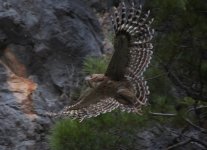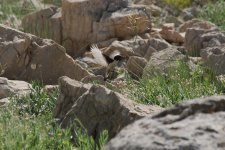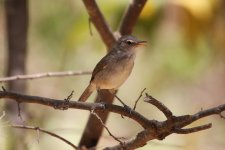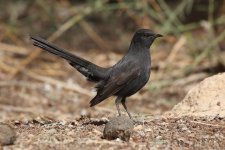Thoughts...........
Bateleur - less than twenty records but one maybe two gettable recently - I'd probably keep in Category 7
Northern Harrier - less than twenty records but with three or four gettable recently - I'd probably keep in Category 7
Pied Crow - the breeding birds did not flourish - though there is one currently in Morocco seen intermittently for a year -
http://www.magornitho.org/2016/03/corvus-albus-mhamid/ - I'd probably keep in Category 7
Dark Chanting Goshawk - I agree - it should now be Category 7
American Coot - Azores, Iceland, every other year longstayers in Britain & Ireland - I'd probably keep in Category 6 - no higher certainly
Pacific Golden Plover - not really sure - Northern Europe mainly? - is it really twitchable several times annually?
Blyth's Pipit - on balance, probably gettable several times annually so Category 5
Hume's Warbler - - on balance, probably gettable several times annually so Category 5
Black Heron - only Cape Verde but guaranteed on Santiago for a decade??
Forster's Tern - available annually in Ireland so I would maintain at Category 5
Mauritania -
https://www.gov.uk/foreign-travel-advice/mauritania - inaccessible to me
Reed Cormorant - Banc d'Arguin -
http://www.netfugl.dk/ranking.php?id=wp&mode=hhhb&species_id=54
Grey-hooded Gull - Banc d'Arguin -
http://www.netfugl.dk/ranking.php?id=wp&mode=hhhb&species_id=377
Blue-naped Mousebird - Choum but arguably no longer present -
http://www.netfugl.dk/ranking.php?id=wp&mode=hhhb&species_id=497
Pygmy Sunbird - Tibesti, Chad - inaccessible to me!
Darter - Hawizeh Marshes, Iraq - inaccessible to me!
African Silverbill - Tamanrasset, Algeria - inaccessible to me!
Pink-backed Pelican - it previously has been regular at Abu Simbel? -
http://www.netfugl.dk/ranking.php?id=wp&mode=hhhb&species_id=58
Lesser White-fronted Goose - it just struck me as range restricted - its just that range is northern Europe
Ruddy Duck - arguably now ungettable? - I know British yearlisters that struggled last year! Definitely no lower.
Greater Spotted Eagle - I agree - it should be Category 2
Gyrfalcon - it does really need specific targeting in my view
Red-knobbed Coot - happy with Category 2 but it does need specific targeting in Spain & Morocco
Yellow-browed Warbler - difficult really - definitely missable unless you think about it as no real sites & only areas at specific times of year?
Shikra - Kuwait & Azerbaijan - it should be Category 3
Crab Plover - Kuwait (unmissable at right time of year) & Egypt - happy with Category 3
Great Black-backed Gull - surprisingly absent/difficult in large parts of the WP as northern & coastal but relaxed!
All the best









